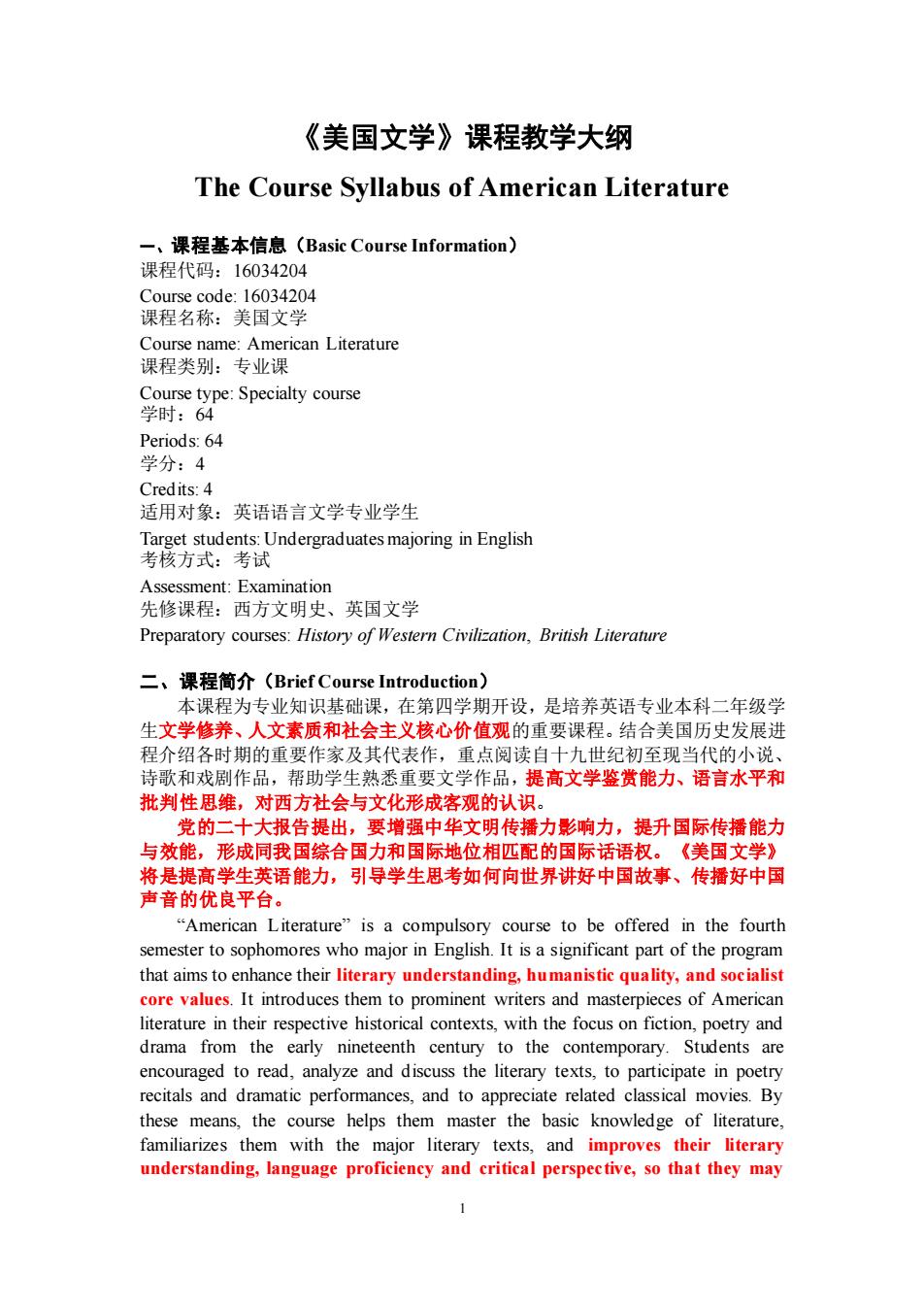
《美国文学》课程教学大纲 The Course Syllabus of American Literature 一、课程基本信息(Basic Course Information) 课程代码:16034204 de:16034204 课程名称美国文 Course name:American Literature 课程类别:专业课 Course type:Specialty course 学时:64 Periods:64 学分:4 Credits:4 适用对象:英语语言文学专业学生 ents:Undergraduates majoring in English 考试 Assessment:Examination 先修课程:西方文明史、英国文学 Preparatory courses:History of Western Civilization.British Literature 二、课程简介(Brief Course Introduction) 本课程为专业知识基础课 在第四学期开设,是培养英语专业本科二年级学 生文学修养、人文素质和社会主义核心价值观的重要课程。结合美国历史发展进 程介绍各时期的重要作家及其代表作,重点阅读自十九世纪初至现当代的小说、 诗歌和戏剧作品,帮助学生熟悉重要文学作品,提高文学鉴赏能力、语言水平和 批判性思维,对西方社会与文化形成客观的认识 当的 大报告提出,要增强中华文明传播力影响力,提升国际传播能力 与效能,形成同我国综合国力和国际地位相匹配的国际话语权。 《美国文学》 将是提高学生英语能力,引导学生思考如何向世界讲好中国故事、传播好中国 声音的优良平台。 "American Literature"is a compulsory course to be offered in the fourth semester to sophomores who major in English.It is a significant part of the program that aims to enhance their literary understanding,humanistic quality,and socialist core values.It introduces them to prominent writers and masterpieces of American literature in their respective historical contexts.with the focus on fiction,poetry and drama from the early nineteenth century to the contemporary.Students are aepate in poetr recitals and dramatic performances,and to appreciate related classical movies.By these means,the course helps them master the basic knowledge of literature, familiarizes them with the major literary texts,and improves their literary understanding,language proficiency and critical perspective,so that they may
1 《美国文学》课程教学大纲 The Course Syllabus of American Literature 一、课程基本信息(Basic Course Information) 课程代码:16034204 Course code: 16034204 课程名称:美国文学 Course name: American Literature 课程类别:专业课 Course type: Specialty course 学时:64 Periods: 64 学分:4 Credits: 4 适用对象:英语语言文学专业学生 Target students: Undergraduates majoring in English 考核方式:考试 Assessment: Examination 先修课程:西方文明史、英国文学 Preparatory courses: History of Western Civilization, British Literature 二、课程简介(Brief Course Introduction) 本课程为专业知识基础课,在第四学期开设,是培养英语专业本科二年级学 生文学修养、人文素质和社会主义核心价值观的重要课程。结合美国历史发展进 程介绍各时期的重要作家及其代表作,重点阅读自十九世纪初至现当代的小说、 诗歌和戏剧作品,帮助学生熟悉重要文学作品,提高文学鉴赏能力、语言水平和 批判性思维,对西方社会与文化形成客观的认识。 党的二十大报告提出,要增强中华文明传播力影响力,提升国际传播能力 与效能,形成同我国综合国力和国际地位相匹配的国际话语权。《美国文学》 将是提高学生英语能力,引导学生思考如何向世界讲好中国故事、传播好中国 声音的优良平台。 “American Literature” is a compulsory course to be offered in the fourth semester to sophomores who major in English. It is a significant part of the program that aims to enhance their literary understanding, humanistic quality, and socialist core values. It introduces them to prominent writers and masterpieces of American literature in their respective historical contexts, with the focus on fiction, poetry and drama from the early nineteenth century to the contemporary. Students are encouraged to read, analyze and discuss the literary texts, to participate in poetry recitals and dramatic performances, and to appreciate related classical movies. By these means, the course helps them master the basic knowledge of literature, familiarizes them with the major literary texts, and improves their literary understanding, language proficiency and critical perspective, so that they may
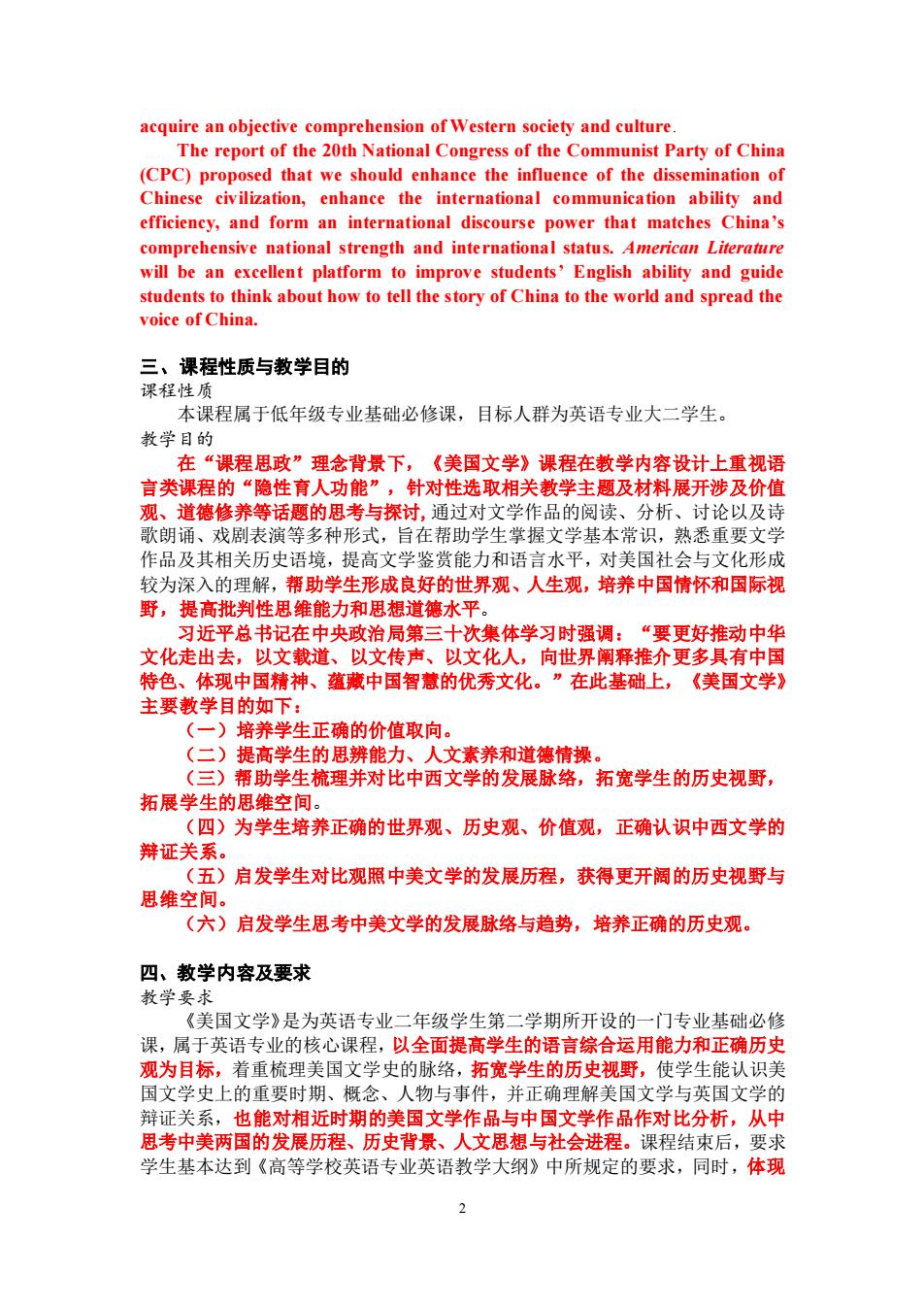
acquire an objective c rehension of Western society and culture (CPC)proposed that we should enhance the influence of the dissemination of Chinese civilization,enhance the international communication ability and efficiency,and form an international discourse power that matches China's comprehensive national strength and international status.American Literature udents'English ability and guide dents to think about how to tell the story of China to the world and spread the voice of China. 三、课程性质与教学目的 课程性盾 本课程属于低年级专业基础必修课,目标人群为英语专业大二学生。 教学目的 在“课程思政”理念背景下,《美国文学》课程在教学内容设计上重视语 言类课程的“隐性育人功能”,针对性选取相关教学主题及材料展开涉及价值 观、道德修养等话题的思考与探讨,通过对文学作品的阅读、分析、讨论以及诗 歌朗诵、戏剧表演等多种形式,旨在帮助学生掌握文学基本常识,熟悉重要文学 作品及其相关历史语境,提高文学鉴赏能力和语言水平,对美国社会与文化形成 较为深入的理解,帮助学生形成良好的世界观、人生观,培养中国情怀和国际视 野,提高批判性思维能力和思想道德水平。 习近平总书记在中央政治局第三十次集体学习时强调:“要更好推动中华 文化走出去,以文载道、以文传声、以文化人,向世界阐释推介更多具有中国 特色、体现中国精神、蕴藏中国智意的优秀文化。”在此基础上, 《美国文学》 主要教学目的如下: (一)培养学生正确的价值取向。 (二)提高学生的思辨能力、人文素养和道德情操。 (三)帮助学生梳理并对比中西文学的发展脉络,拓宽学生的历史视野, 拓展学生的思维空间。 (四)为学生培养正确的世界观、历史观、价值观,正确认识中西文学的 辩证关系。 (五)启发学生对比观照中美文学的发展历程,获得更开阔的历史视野与 思维空间。 (六)启发学生思考中美文学的发展脉络与挡势,培养正确的历史观。 四、教学内容及要求 教学要求 《美国文学》是为英语专业二年级学生第二学期所开设的一门专业基础必修 课,属于英语专业的核心课程,以全面提高学生的语言综合运用能力和正确历史 观为目标,着重梳理美国文学史的脉络,拓宽学生的历史视野,使学生能认识美 国文学史上的重要时期、概念、 入物与事件, 并正确理解美国文学与英国文学的 辩证关系,也能对相近时期的美国文学作品与中国文学作品作对比分析,从中 思考中美两国的发展历程、历史背景、人文思想与社会进程。课程结束后,要求 学生基本达到《高等学校英语专业英语教学大纲》中所规定的要求,同时,体现 2
2 acquire an objective comprehension of Western society and culture. The report of the 20th National Congress of the Communist Party of China (CPC) proposed that we should enhance the influence of the dissemination of Chinese civilization, enhance the international communication ability and efficiency, and form an international discourse power that matches China’s comprehensive national strength and international status. American Literature will be an excellent platform to improve students’ English ability and guide students to think about how to tell the story of China to the world and spread the voice of China. 三、课程性质与教学目的 课程性质 本课程属于低年级专业基础必修课,目标人群为英语专业大二学生。 教学目的 在“课程思政”理念背景下,《美国文学》课程在教学内容设计上重视语 言类课程的“隐性育人功能”,针对性选取相关教学主题及材料展开涉及价值 观、道德修养等话题的思考与探讨,通过对文学作品的阅读、分析、讨论以及诗 歌朗诵、戏剧表演等多种形式,旨在帮助学生掌握文学基本常识,熟悉重要文学 作品及其相关历史语境,提高文学鉴赏能力和语言水平,对美国社会与文化形成 较为深入的理解,帮助学生形成良好的世界观、人生观,培养中国情怀和国际视 野,提高批判性思维能力和思想道德水平。 习近平总书记在中央政治局第三十次集体学习时强调:“要更好推动中华 文化走出去,以文载道、以文传声、以文化人,向世界阐释推介更多具有中国 特色、体现中国精神、蕴藏中国智慧的优秀文化。”在此基础上,《美国文学》 主要教学目的如下: (一)培养学生正确的价值取向。 (二)提高学生的思辨能力、人文素养和道德情操。 (三)帮助学生梳理并对比中西文学的发展脉络,拓宽学生的历史视野, 拓展学生的思维空间。 (四)为学生培养正确的世界观、历史观、价值观,正确认识中西文学的 辩证关系。 (五)启发学生对比观照中美文学的发展历程,获得更开阔的历史视野与 思维空间。 (六)启发学生思考中美文学的发展脉络与趋势,培养正确的历史观。 四、教学内容及要求 教学要求 《美国文学》是为英语专业二年级学生第二学期所开设的一门专业基础必修 课,属于英语专业的核心课程,以全面提高学生的语言综合运用能力和正确历史 观为目标,着重梳理美国文学史的脉络,拓宽学生的历史视野,使学生能认识美 国文学史上的重要时期、概念、人物与事件,并正确理解美国文学与英国文学的 辩证关系,也能对相近时期的美国文学作品与中国文学作品作对比分析,从中 思考中美两国的发展历程、历史背景、人文思想与社会进程。课程结束后,要求 学生基本达到《高等学校英语专业英语教学大纲》中所规定的要求,同时,体现

“课程思政”的理念优势,能做到: (一)理解并践行有特色的社会主义的制度自信、理论自信和道路自信 (二)养成正确的价值观与道德观,具有较高的思辨能力与人物素养 (三)初步理解和掌握美国 的脉络 (四)了解美国文学史主要发展时期及每个时期的重要历史、社会、政治 哲学、文学、等方面的背景、人物与事件。 (五)运用英语语言能力分析并表达重要思想家、文学家或艺术家的作品 (六)对比观照中美文学的发展历程,获得更开潮的历史视野与思维空间, (七)思考中美文学的发展脉络与趋势,弘扬中华文化独特的价值与世界 观、价值观,培养正确的历史观。 (八)帮助学生掌握高年级课程中的相关内容及概念。 教学内容 本课程选用的教材为陶洁的美国文学选读( 三版) 试图从世界文学彼此 联系互动的视角,全方位地展示美国文学的发展历程。课本合共27章,覆盖列 民时期(约1607-1765)、启蒙时期与独立战争时期(1765-18世纪末)、浪漫 主义时期(1800-1865)、现实主义时期(1865.1918)、现代主义时期(1918-1945)、 当代文学(1945-)的美国文学史。 具体教学内容如下 Part I The Colonial Period 目的与要求 1.了解美洲殖民地时期文学的概况: 2.研究清教主义及其对美国价值观的影响。 3.帮助学生了解西方文化的发展脉络,培养学生全球视野、独立观察和批判性 思维 教学内容 1.主要内容 1.1 beginning of American literature-the early 1600s: 1.1.1 Englishmen describing the English exploration and colonization of the New World (America) 1.1.2 Tales of adve nd tement;facts+fantasy 1.2 Captain John Smith(1580-1631) 1.2.1 a real adventurer,helped found Jamestown in 1607(the first English colony in America) 12 2 True Relation of virginia (1608)and Description of New England (1616) fascinating"advertisements"which try to persuade the reader to Settleln the New World 1.3 General History of Virginia,New England and the Summer Isles(1624),the first famous tale from American literature. IlI Differences between the southern and the new england colonies 1.3.1 In the South,enormous farms or plantations used the labor of black slaves to grow tobacco.The rich and p verful pl er slow to develop literature of their own.They preferred books imported from England
3 “课程思政”的理念优势,能做到: (一)理解并践行有特色的社会主义的制度自信、理论自信和道路自信。 (二)养成正确的价值观与道德观,具有较高的思辨能力与人物素养。 (三)初步理解和掌握美国文学史的脉络。 (四)了解美国文学史主要发展时期及每个时期的重要历史、社会、政治、 哲学、文学、等方面的背景、人物与事件。 (五)运用英语语言能力分析并表达重要思想家、文学家或艺术家的作品。 (六)对比观照中美文学的发展历程,获得更开阔的历史视野与思维空间。 (七)思考中美文学的发展脉络与趋势,弘扬中华文化独特的价值与世界 观、价值观,培养正确的历史观。 (八)帮助学生掌握高年级课程中的相关内容及概念。 教学内容 本课程选用的教材为陶洁的美国文学选读(第三版),试图从世界文学彼此 联系互动的视角,全方位地展示美国文学的发展历程。课本合共 27 章,覆盖殖 民时期(约 1607-1765)、启蒙时期与独立战争时期(1765-18 世纪末)、浪漫 主义时期(1800-1865)、现实主义时期(1865-1918)、现代主义时期(1918-1945)、 当代文学(1945-)的美国文学史。 具体教学内容如下: Part I The Colonial Period (一) 目的与要求 1. 了解美洲殖民地时期文学的概况; 2. 研究清教主义及其对美国价值观的影响。 3. 帮助学生了解西方文化的发展脉络,培养学生全球视野、独立观察和批判性 思维. (二) 教学内容 1. 主要内容 1.1 beginning of American literature — the early 1600s: 1.1.1 Englishmen describing the English exploration and colonization of the New World (America) 1.1.2 Tales of adventure and excitement; facts + fantasy 1.2 Captain John Smith (1580-1631) l.2.1 a real adventurer; helped found Jamestown in 1607 (the first English colony in America) 1.2.2 True Relation of Virginia (1608) and Description of New England (1616); fascinating “advertisements” which try to persuade the reader to Settle1n the New World; 1.3 General History of Virginia, New England and the Summer Isles (1624); the first famous tale from American literature. III. Differences between the Southern: and the New England colonies 1.3.1 In the South, enormous farms or plantations used the labor of black slaves to grow tobacco. The rich and powerful plantation owners were slow to develop a literature of their own. They preferred books imported from England
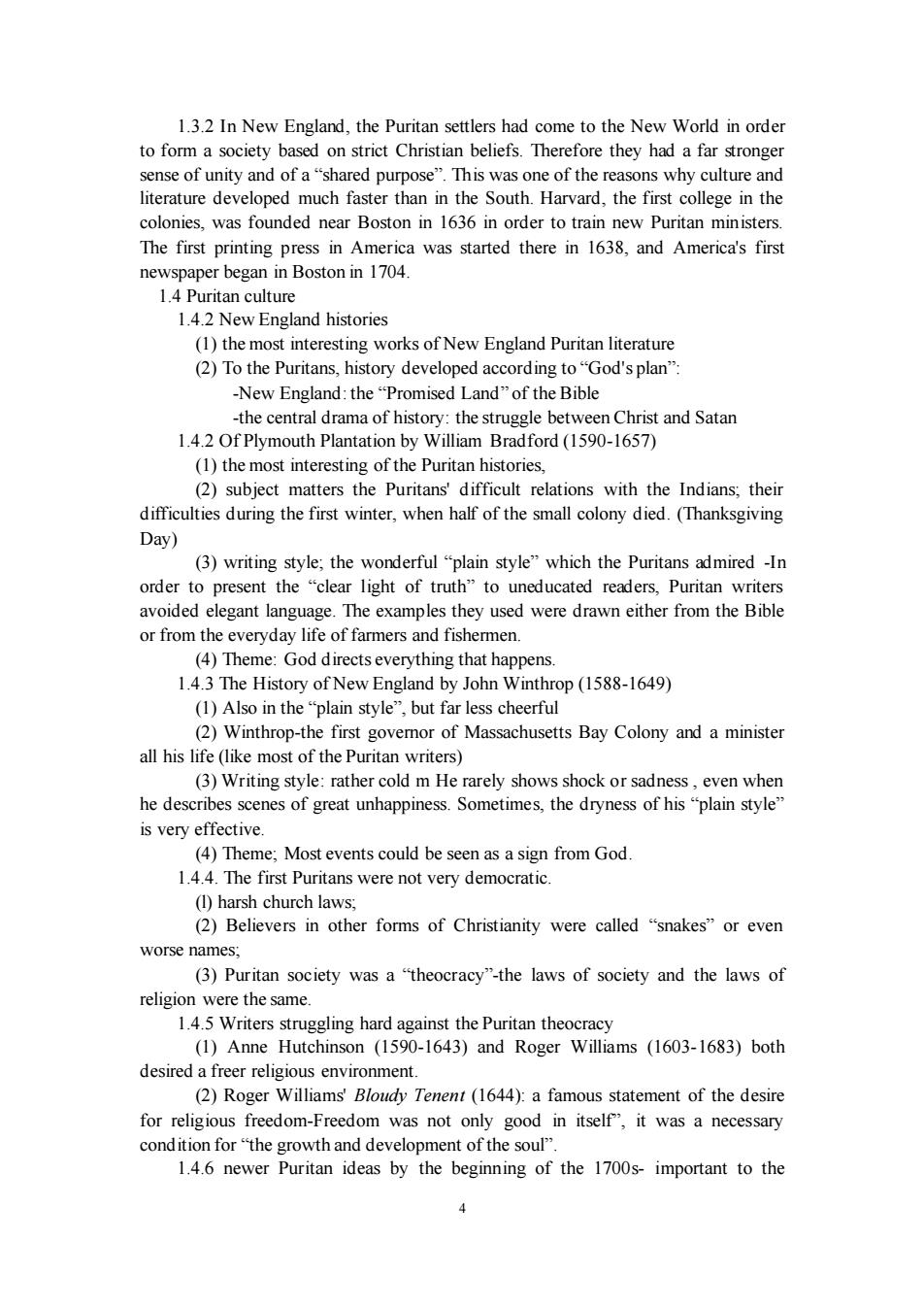
1.3.2 In New England,the Puritan settlers had come to the New World in orde to form a society based on strict Christian beliefs.Therefore they had a far stronge sense of unity and of a"shared purpose".This was one of the reasons why culture and literature developed much faster than in the South.Harvard.the first college in the colonies,was founded near Boston in 1636 in order to train new Puritan ministers. The first printing press in America was started there in 1638,and America's first newspap er began in. 1.4 Puritan culture 1.4.2 New England histories (1)the most interesting works of New England Puritan literature (2)To the Puritans.history developed according to"God's plan" -New England:thePromised d Land"of the Bible e central drama of history:the struggle between Christ and Satan 1.4.2 Of Plymouth Plantation by William Bradford (1590-1657) (1)the most interesting of the Puritan histories. (2)subject matters the Puritans'difficult relations with the Indians:their difficulties during the first winter,when half of the small colony died.(Thanksgiving Day) (3)writing style;the wonderful"plain style"which the Puritans admired-In order to present the"clear light of truth"to uneducated readers.Puritan writers avoided elegant language.The examples they used were drawn either from the Bible or from the everyday life of farmers and fishermen. (4)The 14.3 The Hist ne:God directs verything that ory of New England by John Winthrop(1588-1649) (1)Also in the "plain style".but far less cheerful (2)Winthrop-the first govemor of Massachusetts Bay Colony and a minister all his life (like most of the Puritan writers) (3)Writing style:rather cold m He rarely shows shock or sadn ev of great unhappiness.Sometimes,the dryness of his"plain style is very effective. (4)Theme:Most events could be seen as a sign from God 1.4.4.The first Puritans were not very democratic. (1)harsh church laws; (2)Belie in other forms of Christianity were called "snakes"or even worse names. (3)Puritan society was a "theocracy"-the laws of society and the laws of religion were the same. 1.4.5 Writers struggling hard against the Puritan theocr (1)Anne Hutc 1590-1643) nd Roger ams(1603-1683)both desired a freer religious environmen (2)Roger Williams Bloudy Tenent (1644):a famous statement of the desire for religious freedom-Freedom was not only good in itself,it was a necessary condition for"the growth and development of the soul" 1 4 6 newer puritan ideas by the beginning of the 1700s-important to the
4 1.3.2 In New England, the Puritan settlers had come to the New World in order to form a society based on strict Christian beliefs. Therefore they had a far stronger sense of unity and of a “shared purpose”. This was one of the reasons why culture and literature developed much faster than in the South. Harvard, the first college in the colonies, was founded near Boston in 1636 in order to train new Puritan ministers. The first printing press in America was started there in 1638, and America's first newspaper began in Boston in 1704. 1.4 Puritan culture 1.4.2 New England histories (1) the most interesting works of New England Puritan literature (2) To the Puritans, history developed according to “God's plan”: -New England: the “Promised Land” of the Bible -the central drama of history: the struggle between Christ and Satan 1.4.2 Of Plymouth Plantation by William Bradford (1590-1657) (1) the most interesting of the Puritan histories, (2) subject matters the Puritans' difficult relations with the Indians; their difficulties during the first winter, when half of the small colony died. (Thanksgiving Day) (3) writing style; the wonderful “plain style” which the Puritans admired -In order to present the “clear light of truth” to uneducated readers, Puritan writers avoided elegant language. The examples they used were drawn either from the Bible or from the everyday life of farmers and fishermen. (4) Theme: God directs everything that happens. 1.4.3 The History of New England by John Winthrop (1588-1649) (1) Also in the “plain style”, but far less cheerful (2) Winthrop-the first governor of Massachusetts Bay Colony and a minister all his life (like most of the Puritan writers) (3) Writing style: rather cold m He rarely shows shock or sadness , even when he describes scenes of great unhappiness. Sometimes, the dryness of his “plain style” is very effective. (4) Theme; Most events could be seen as a sign from God. 1.4.4. The first Puritans were not very democratic. (l) harsh church laws; (2) Believers in other forms of Christianity were called “snakes” or even worse names; (3) Puritan society was a “theocracy”-the laws of society and the laws of religion were the same. 1.4.5 Writers struggling hard against the Puritan theocracy (1) Anne Hutchinson (1590-1643) and Roger Williams (1603-1683) both desired a freer religious environment. (2) Roger Williams' Bloudy Tenent (1644): a famous statement of the desire for religious freedom-Freedom was not only good in itself”, it was a necessary condition for “the growth and development of the soul”. 1.4.6 newer Puritan ideas by the beginning of the 1700s- important to the

development of democracy 14.7The New Englanders keeping"urity of Puritanism during the early,difficult days of settlement.But when the Indians wer no longer a danger,the dark forests had become farmland.and more comfortable settlements had grown up,Puritan strictness began to relax.The change was very slow and was not easily recognized by new englanders at the time 14.8 The anic in the 1690s town of Salem,Ma ssachusett: young girls and lonely old wome wereamested and putos withes.number of these people were puttodeath for“selling their souls”to the Devil (2)The "Salem witch trials"showed the psychological environment of the time and the Puritans,strange beliefs:to many Puritans of the time,witchcraft and other fo ere an al (1)Anne Bradstreet (1612-1672) -the first real New England poet -Tenth Muse Lately Sprung Up In America(1650):containing the first New World and his poetry written during the last years of the Puritan theocracy;some of the finest poetry written in Colonial America -Taylor hoped for a'“rebirth"of the“Puritan Way” 1.4.10 Sudden s xplosions of religious emotion throughout American history. even in the 20th century 1.4.11.The Puritans admired science as the study of God's material creation (1)Edwards developed this idea further-He said that there was a close relation between knowledge of the physical world and knowledge of the spiritual world. (2)This idea created a bridge between the old:strict Puritan society and the which came later with its s entific s study of the world. New England histories;Puritanism 3.问题与应用 What are the main ideas of Puritan thought in colonial america? (三)思考与实践 How does Puritanisr help shape the American Value today? (四)教学方法与手 1,教学方法:课堂讲授与讨论相结合 2.教学手段:多媒体课件 Part II The Enlightenment and Revolutionary Period (一)目的与要求 1,讲解早期英国民族迁徙和族裔构成对美国文学的影响,培养学生的全局思维 和观察能力:
5 development of democracy 1.4.7 The New Englanders were quite successful at keeping the absolute “purity” of Puritanism during the early, difficult days of settlement. But when the Indians were no longer a danger, the dark forests had become farmland, and more comfortable settlements had grown up, Puritan strictness began to relax. The change was very slow and was not easily recognized by New Englanders at the time. 1.4.8 The great witchcraft panic in the 1690s (1) In the town of Salem, Massachusetts, young girls and lonely old women were arrested and put on trial as witches. A number of these people were put to death for “selling their souls” to the Devil. (2) The “Salem witch trials” showed the psychological environment of the time and the Puritans, strange beliefs: to many Puritans of the time, witchcraft and other forms of evil were an absolutely real part of everyday life. 1.4.9 Religious themes of the poems of the earliest Puritans (1) Anne Bradstreet (1612-l672) -the first real New England poet -Tenth Muse Lately Sprung Up In America (1650) : containing the first New World poems published in England. (2) Edward Taylor (1645-1729) - his poetry written during the last years of the Puritan theocracy; some of the finest poetry written in Colonial America -Taylor hoped for a “rebirth” of the “Puritan Way”. 1.4.10 Sudden explosions of religious emotion throughout American history, even in the 20th century 1.4.11. The Puritans admired science as the study of God's material creation”. (1) Edwards developed this idea further-He said that there was a close relation between knowledge of the physical world and knowledge of the spiritual world. (2) This idea created a bridge between the old: strict Puritan society and the new, freer culture which came later, with its scientific study of the world. 2. 基本概念和知识点 New England histories; Puritanism 3. 问题与应用 What are the main ideas of Puritan thought in colonial America? (三)思考与实践 How does Puritanism help shape the American Value today? (四)教学方法与手段 1. 教学方法:课堂讲授与讨论相结合 2. 教学手段:多媒体课件 Part II The Enlightenment and Revolutionary Period (一) 目的与要求 1. 讲解早期英国民族迁徙和族裔构成对美国文学的影响,培养学生的全局思维 和观察能力;
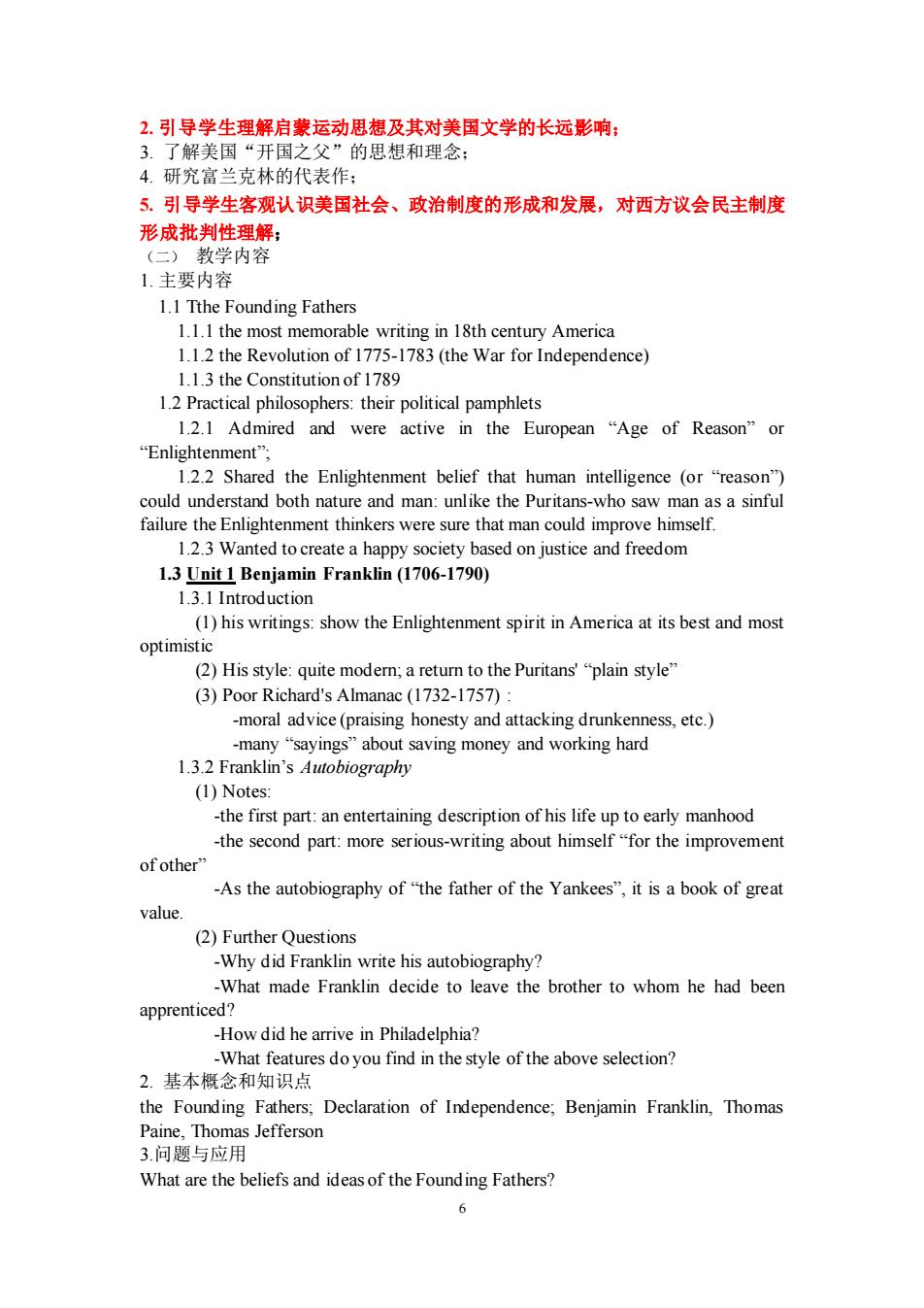
2.引导学生理解启蒙运动思想及其对美国文学的长远影响 . 了解美国 开国之父”的思想和理念: 4.研究富兰克林的代表作: 5.引导学生客观认识类国社会、政治制度的形成和发展,对西方议会民主制度 形成批判性理解: (二)教学内容 1.主要内容 1.1 Tthe Founding Fathers 1.1.1 the most memorable writing in 18th century America 1.1.2 the Revolution of 1775-1783(the War for Independence) 1.1.3 the Constitution of 1789 1.2 Practical philosophers:their political pamphlets 1.2.1 Admired and were active in the European "Age of Reason"or “Enlightenment, 1.2.2 Shared the Enlightenment belief that human intelligence (or "reason") could understand both nature and man:unlike the Puritans-who saw man as a sinful failure the Enlightenment thinkers were sure that man could improve himself. 1.2.3 Wanted to reate a happy s iety bas sed on justice nd freedom 1.3 Unit 1 Benjamin Franklin (1706-1790) 1.3.I Introduction (1)his writings:show the Enlightenment spirit in America at its best and most optimistic (2)His style:quite modem;a retum to the Puritans'plain style" (3)Poor Richard's Almanac(1732-1757) -moral advice(praising honesty and attacking drunkenness,etc.) many "sayings about saving money and working hard 1.3.2 Franklin's Autobiography (1)Notes: the first part:an entertaining description of his life uptoearly manhood -the second part:more serious-writing about himself "for the improvement of other -As the autobiography of"the father of the Yankees",it is a book of great value (②)Further Question -Why did Franklin write his autobiography? -What made Franklin decide to leave the brother to whom he had been apprenticed? -How did he arrive in philadelphia? What fea esdoyou find in the style of the above selection? 2.基本概念和知识 the Founding Fathers;Declaration of Independence;Benjamin Franklin,Thomas Paine,Thomas Jefferson 3.问题与应用 What are the beliefs and ideas of the Founding Fathers? 6
6 2. 引导学生理解启蒙运动思想及其对美国文学的长远影响; 3. 了解美国“开国之父”的思想和理念; 4. 研究富兰克林的代表作; 5. 引导学生客观认识美国社会、政治制度的形成和发展,对西方议会民主制度 形成批判性理解; (二) 教学内容 1. 主要内容 1.1 Tthe Founding Fathers 1.1.1 the most memorable writing in 18th century America 1.1.2 the Revolution of 1775-1783 (the War for Independence) 1.1.3 the Constitution of 1789 1.2 Practical philosophers: their political pamphlets 1.2.1 Admired and were active in the European “Age of Reason” or “Enlightenment”; 1.2.2 Shared the Enlightenment belief that human intelligence (or “reason”) could understand both nature and man: unlike the Puritans-who saw man as a sinful failure the Enlightenment thinkers were sure that man could improve himself. 1.2.3 Wanted to create a happy society based on justice and freedom 1.3 Unit 1 Benjamin Franklin (1706-1790) 1.3.1 Introduction (1) his writings: show the Enlightenment spirit in America at its best and most optimistic (2) His style: quite modern; a return to the Puritans' “plain style” (3) Poor Richard's Almanac (1732-1757) : -moral advice (praising honesty and attacking drunkenness, etc.) -many “sayings” about saving money and working hard 1.3.2 Franklin’s Autobiography (1) Notes: -the first part: an entertaining description of his life up to early manhood -the second part: more serious-writing about himself “for the improvement of other” -As the autobiography of “the father of the Yankees”, it is a book of great value. (2) Further Questions -Why did Franklin write his autobiography? -What made Franklin decide to leave the brother to whom he had been apprenticed? -How did he arrive in Philadelphia? -What features do you find in the style of the above selection? 2. 基本概念和知识点 the Founding Fathers; Declaration of Independence; Benjamin Franklin, Thomas Paine, Thomas Jefferson 3.问题与应用 What are the beliefs and ideas of the Founding Fathers?
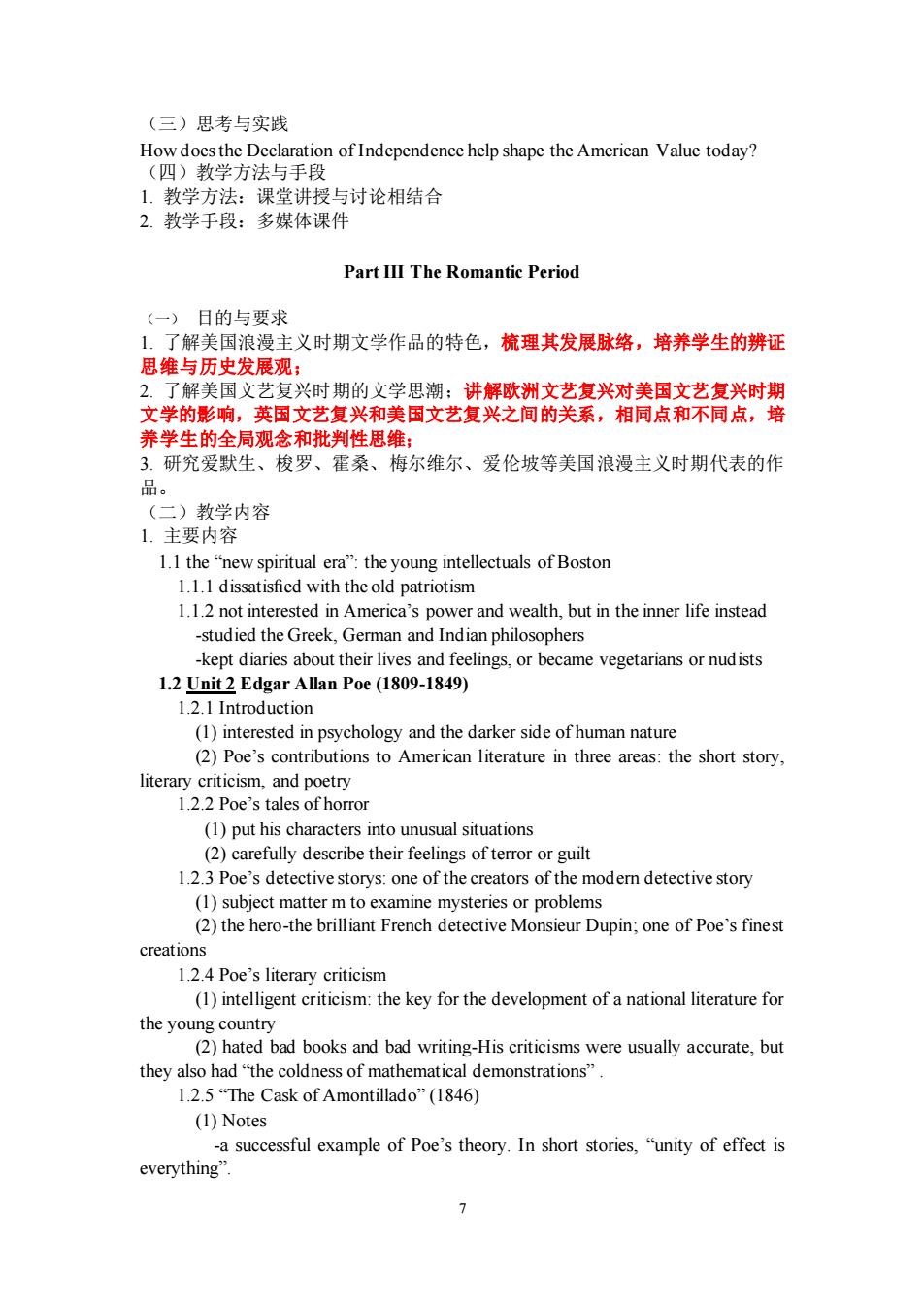
(三)思考与实践 How does tion of Independence help shape the American Value today? 1.教学方法:课堂讲授与讨论相结合 2.教学手段:多媒体课件 Part III The Romantic Period (一)目的与要求 1.了解美国浪漫主义时期文学作品的特色,梳理其发展脉络,培养学生的辨证 思维与历史发展观: 2.了解美国文艺复兴时期的文学思潮:讲解欧洲文艺复兴对美国文艺复兴时期 文学的影响,英国文艺复兴和美国文艺复兴之间的关系,相同点和不同点,培 养学生的全局观念和批判性思维 3.研究爱默生、梭罗、霍桑、梅尔维尔、爱伦坡等美国浪漫主义时期代表的作 品。 (二)教学内容 1.主要内容 1.1 the"ew spiritual era"the young intellectuals of Boston 1.1.1 dissatisfied with theold patriotism 1.1 2 not interested in America's power and wealth.but in the inner life instead -studied the Greek.German and Indian philosophers -kept diaries about their lives and feelings,or became vegetarians or nudists o () (1)interested in psychology and the darker side of human nature (2)Poe's contributions to American literature in three areas:the short story, literary criticism,and poetry 12.2 Poe's tales of horror (1)put his characters into unusual situations (2)carefully describe their feelings of terror or guilt 1.2.3 Poe's detective storys:one of the creators of the modern detective story (1)subiect matter m to examine mysteries or problems (2)the hero-the brilliant French detective Monsieur Dupin;one of Poe's finest creations 1.2.4 Poe's literary criticism (1)intelligent criticism:the key for the development of a national literature for the young country (2)hated bad books and bad writing-His criticisms were usually accurate,but they also had"the coldn s of 1.2.5The Cask of Amontillado demonstrations" ”(1846 (1)Notes -a successful example of Poe's theory.In short stories,"unity of effect is everything
7 (三)思考与实践 How does the Declaration of Independence help shape the American Value today? (四)教学方法与手段 1. 教学方法:课堂讲授与讨论相结合 2. 教学手段:多媒体课件 Part III The Romantic Period (一) 目的与要求 1. 了解美国浪漫主义时期文学作品的特色,梳理其发展脉络,培养学生的辨证 思维与历史发展观; 2. 了解美国文艺复兴时期的文学思潮;讲解欧洲文艺复兴对美国文艺复兴时期 文学的影响,英国文艺复兴和美国文艺复兴之间的关系,相同点和不同点,培 养学生的全局观念和批判性思维; 3. 研究爱默生、梭罗、霍桑、梅尔维尔、爱伦坡等美国浪漫主义时期代表的作 品。 (二)教学内容 1. 主要内容 1.1 the “new spiritual era”: the young intellectuals of Boston 1.1.1 dissatisfied with the old patriotism 1.1.2 not interested in America’s power and wealth, but in the inner life instead -studied the Greek, German and Indian philosophers -kept diaries about their lives and feelings, or became vegetarians or nudists 1.2 Unit 2 Edgar Allan Poe (1809-1849) 1.2.1 Introduction (1) interested in psychology and the darker side of human nature (2) Poe’s contributions to American literature in three areas: the short story, literary criticism, and poetry 1.2.2 Poe’s tales of horror (1) put his characters into unusual situations (2) carefully describe their feelings of terror or guilt 1.2.3 Poe’s detective storys: one of the creators of the modern detective story (1) subject matter m to examine mysteries or problems (2) the hero-the brilliant French detective Monsieur Dupin; one of Poe’s finest creations 1.2.4 Poe’s literary criticism (1) intelligent criticism: the key for the development of a national literature for the young country (2) hated bad books and bad writing-His criticisms were usually accurate, but they also had “the coldness of mathematical demonstrations” . 1.2.5 “The Cask of Amontillado” (1846) (1) Notes -a successful example of Poe’s theory. In short stories, “unity of effect is everything
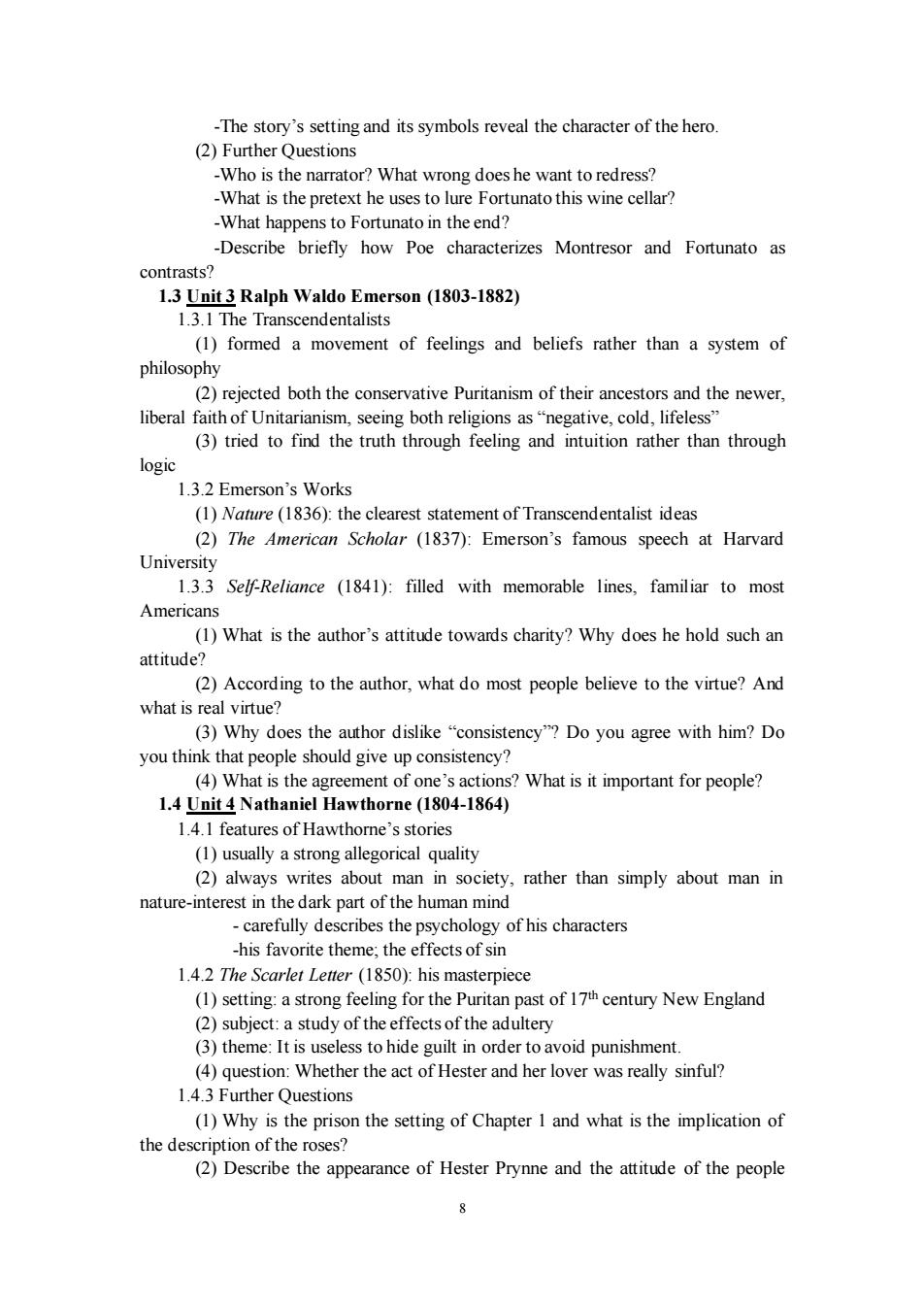
The its symo reveal the of (2)Further Questions -Who is the narrator?What wrong does he want to redress? -What is the pretext he uses to lure Fortunato this wine cellar? -What happens to Fortunato in the end? -Describe briefly how Poe characterizes Montresor and Fortunato as contrasts? 1.3 Unit 3 Ralph Waldo Emerson(1803-1882) 1.3.I The Transcendentalists (1)formed a movement of feelings and beliefs rather than a system of philosophy lheral of Unitarianism,secing both relgions as ngative,cold.lifeles ted both the conservative Puritanism of their ance s and the newer (3)tried to find the truth through feeling and intuition rather than through logic 1 32 Emerson's Works (1)(1836):the clearest statement of Transcendentalist ideas (2)The American Scholar(1837):Emerson's famous speech at Harvard University 1.3.3 SelfReliance (1841):filled with memorable lines.familiar to most Americans (1)What is the author's attitude towards charity?Why does he hold such an (2)According to the author,what do most people believe to the virtue?And what is real virtue? (3)Why does the author dislike "consistency"?Do you agree with him?Do you think that people should give up consistency? 1.4 Unit Nathanicl Hawthorne (1 s the as nt of one's actions?What is it important for people? 1.4.1 features of Hawthorne's stories (1 usually a strong allegorical quality (2)always writes about man in society,rather than simply about man in nature-interest in the dark part of the human mind carefully describes the of his characters his favorite theme the effects of sir 1.4.2 The Scarlet Letter (1850):his masterpiece (1)setting:a strong feeling for the Puritan past of 17th century New England (2)subiect:a study of the effects of the adultery (3)th e Itis Iseless to hide uiti n order avoid punishment (4)question:Whether the act of Hester and her lover was really sinful? 1.4.3 Further Questions (1)Why is the prison the setting of Chapter 1 and what is the implication of the description of the roses? (2)Describe the appearance of Hester Prynne and the attitude of the people
8 -The story’s setting and its symbols reveal the character of the hero. (2) Further Questions -Who is the narrator? What wrong does he want to redress? -What is the pretext he uses to lure Fortunato this wine cellar? -What happens to Fortunato in the end? -Describe briefly how Poe characterizes Montresor and Fortunato as contrasts? 1.3 Unit 3 Ralph Waldo Emerson (1803-1882) 1.3.1 The Transcendentalists (1) formed a movement of feelings and beliefs rather than a system of philosophy (2) rejected both the conservative Puritanism of their ancestors and the newer, liberal faith of Unitarianism, seeing both religions as “negative, cold, lifeless” (3) tried to find the truth through feeling and intuition rather than through logic 1.3.2 Emerson’s Works (1) Nature (1836): the clearest statement of Transcendentalist ideas (2) The American Scholar (1837): Emerson’s famous speech at Harvard University 1.3.3 Self-Reliance (1841): filled with memorable lines, familiar to most Americans (1) What is the author’s attitude towards charity? Why does he hold such an attitude? (2) According to the author, what do most people believe to the virtue? And what is real virtue? (3) Why does the author dislike “consistency”? Do you agree with him? Do you think that people should give up consistency? (4) What is the agreement of one’s actions? What is it important for people? 1.4 Unit 4 Nathaniel Hawthorne (1804-1864) 1.4.1 features of Hawthorne’s stories (1) usually a strong allegorical quality (2) always writes about man in society, rather than simply about man in nature-interest in the dark part of the human mind - carefully describes the psychology of his characters -his favorite theme; the effects of sin 1.4.2 The Scarlet Letter (1850): his masterpiece (1) setting: a strong feeling for the Puritan past of 17th century New England (2) subject: a study of the effects of the adultery (3) theme: It is useless to hide guilt in order to avoid punishment. (4) question: Whether the act of Hester and her lover was really sinful? 1.4.3 Further Questions (1) Why is the prison the setting of Chapter 1 and what is the implication of the description of the roses? (2) Describe the appearance of Hester Prynne and the attitude of the people

towardsher (3)What has happened to Heste Why does she make the embroidery of the letterAso elaborate?How doesthis tell us about her character 1.5 Unit 5 Herman Melville (1819-1891) 15.1 Introduction (1)became a sailor at age twenty m his most important experience in life (life at sea mpo rtant material for his books and short stories ories (1)more than simple sea adventures-the voyages of his heroes:searches for the truth (2)In his fiction.man lives in a world divided into two warring parts:good these opposites (3)tragic view of life:The universe itself is working against human happiness and peace of mind.The world has no place for pure goodness or pure evil. 15.3ob-Dick(1851) (1)the greatest novel of american literature (2)th (Moby-Dic of the whali equod;a symbolic k.the grea voyage e:represents God or fate (4)a great deal of factual information about whale-hunting:to make the world of Moby-Dick seem real (5)Captain Ahab.the central Character and,ungodly,God-like man" y and his desire todestroy the white whale -These two sides-the light and the dark-fight each other in Ahab -theme:Personal identity is only an illusion 1.5.4 Further Questions (1)What are the stories Ishmael tells about Moby Dick? (2)Why does Ahab act so violently nst the white whale?Ishmael suggests that Ahab is“cray”and callshim“a raving lunatic..”Do you agree with him Why or why not? (3)What narrative features can you find in the selected chapter? 1.6 Unit 6 Henry David Thoreau (1817-1862) 1.6.1 putting into practice nany of Emerson's theories;an experienced woodsman whos works are filled with details about plants,rivers and wildlife 1.6.2 Civil Disobedience (1849) (1)about his experience in jail in 1846 (2)theme:"we should be men first and subjects afterward" (3)great influence on Tolstoy,Gandhiand Martin Luther King (4)the best-knc wn Am n essay outs ide the United States 1.63 Walden1854到 (1)Notes -about his stay in the hut(1845-1847)he built for himself on the north shore of Walden Pond
9 towards her. (3) What has happened to Hester? Why does she make the embroidery of the letter A so elaborate? How does this tell us about her character? 1.5 Unit 5 Herman Melville (1819-1891) 1.5.1 Introduction (1) became a sailor at age twenty m his most important experience in life (2) life at sea—the most important material for his books and short stories 1.5.2 features of Melville’s stories (1) more than simple sea adventures -the voyages of his heroes: searches for the truth (2) In his fiction, man lives in a world divided into two warring parts: good against evil, God against Satan, the “head” against the “heart” -no way to overcome these opposites (3) tragic view of life: The universe itself is working against human happiness and peace of mind. The world has no place for pure goodness or pure evil. 1.5.3 Moby-Dick (1851) (1) the greatest novel of American literature (2) the voyage of the whaling ship Pequod; a symbolic voyage (3) Moby-Dick, the great White whale: represents God or fate (4) a great deal of factual information about whale - hunting; to make the world of Moby-Dick seem real (5) Captain Ahab, the central Character -“a grand, ungodly, God-like man” -torn between his humanity and his desire to destroy the white whale - These two sides -the light and the dark -fight each other in Ahab. - theme: Personal identity is only an illusion 1.5.4 Further Questions (1) What are the stories Ishmael tells about Moby Dick? (2) Why does Ahab react so violently against the white whale? Ishmael suggests that Ahab is “crazy” and calls him “a raving lunatic.” Do you agree with him? Why or why not? (3) What narrative features can you find in the selected chapter? 1.6 Unit 6 Henry David Thoreau (1817-1862) 1.6.1 putting into practice many of Emerson’s theories; an experienced woodsman whose works are filled with details about plants, rivers and wildlife 1.6.2 Civil Disobedience (1849) (1) about his experience in jail in 1846 (2) theme: “we should be men first and subjects afterward” (3) great influence on Tolstoy, Gandhi and Martin Luther King (4) the best-known American essay outside the United States 1.6.3 Walden (1854) (1) Notes -about his stay in the hut (1845-1847) he built for himself on the north shore of Walden Pond
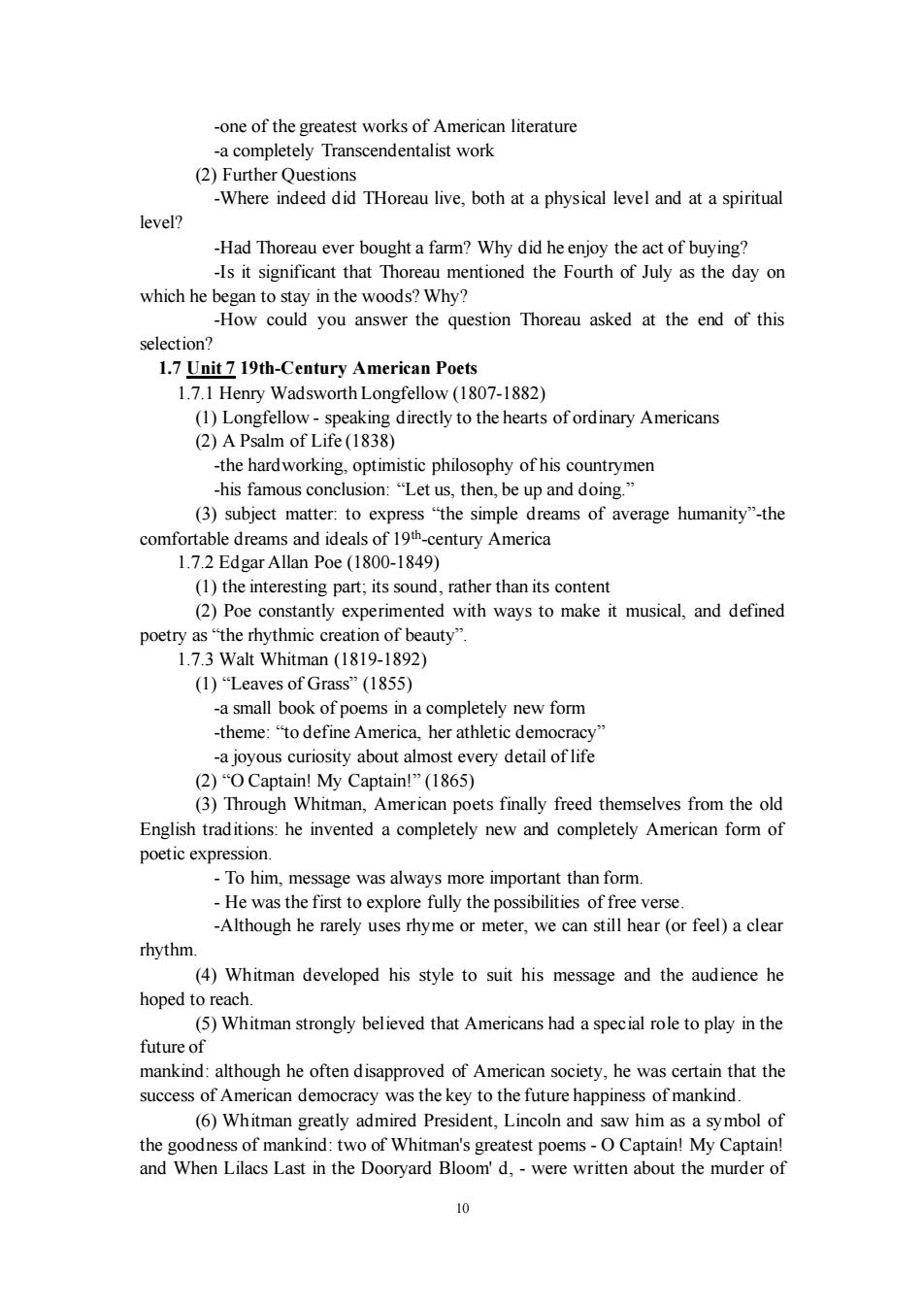
(2)Further Questions -Where indeed did THoreau live.both at a physical level and at a spiritual level? -Had Thoreau ever bought a farm?Why did he enjoy the act of buying? Is it significa which he began to stay in the woods?Why? -How could you answer the question Thoreau asked at the end of this selection? 1.7 Unit 7 19th-Century American Poets 1.7.1 Henry Wadsworth Longfellow(1807-1882) speaking directly to the hearts of ordinary Americans (2)A Psalm of Life(1838) -the hard working.optimistic philosophy of his countrymen -his famous conclusion:"Let us,then,be up and doing." (3)subject matter.to express"the simple dreams of average humanity"-the comfor and ideals of1 century America (1)the interesting part;its sound,rather than its content (2)Poe constantly experimented with ways to make it musical,and defined poetry as"the rhythmic creation of beauty" 1.7.3 Walt Whitman(1819-1892) ()Leaves of Grass”(1855 -a small book of poems in a completely new form -theme:"to define America,her athletic democracy" -a joyous curiosity about almost every detail of life (2)Captain!My Captain!"(185) (3)Through Whitman American p oets finally freed themselves from the old English traditions:he invented a completely new and completely American form of poetic expression. -To him.message was always more important than form -He was the first to explore fully the possibilities of free verse -Altho r,we can still hear (or feel)a clear rhythm (4)Whitman developed his style to suit his message and the audience he hoped to reach. (5)Whitman strongly believed that Americans had a special role to play in the future of mankind:although he often disapproved of American society,he was certain that the success of American democracy was the key to the future happiness of mankind. (6)Whitman greatly admired President,Lincoln and saw him as a symbol of the goodness of mankind:two of Whitman's greatest poems-O Captain!My Captain! and When Lilacs Last in the Dooryard Bloom'd.-were written about the murder of 10
10 -one of the greatest works of American literature -a completely Transcendentalist work (2) Further Questions -Where indeed did THoreau live, both at a physical level and at a spiritual level? -Had Thoreau ever bought a farm? Why did he enjoy the act of buying? -Is it significant that Thoreau mentioned the Fourth of July as the day on which he began to stay in the woods? Why? -How could you answer the question Thoreau asked at the end of this selection? 1.7 Unit 7 19th-Century American Poets 1.7.1 Henry Wadsworth Longfellow (1807-1882) (1) Longfellow - speaking directly to the hearts of ordinary Americans (2) A Psalm of Life (1838) -the hardworking, optimistic philosophy of his countrymen -his famous conclusion: “Let us, then, be up and doing.” (3) subject matter: to express “the simple dreams of average humanity”-the comfortable dreams and ideals of 19th -century America 1.7.2 Edgar Allan Poe (1800-1849) (1) the interesting part; its sound, rather than its content (2) Poe constantly experimented with ways to make it musical, and defined poetry as “the rhythmic creation of beauty”. 1.7.3 Walt Whitman (1819-1892) (1) “Leaves of Grass” (1855) -a small book of poems in a completely new form -theme: “to define America, her athletic democracy” -a joyous curiosity about almost every detail of life (2) “O Captain! My Captain!” (1865) (3) Through Whitman, American poets finally freed themselves from the old English traditions: he invented a completely new and completely American form of poetic expression. - To him, message was always more important than form. - He was the first to explore fully the possibilities of free verse. -Although he rarely uses rhyme or meter, we can still hear (or feel) a clear rhythm. (4) Whitman developed his style to suit his message and the audience he hoped to reach. (5) Whitman strongly believed that Americans had a special role to play in the future of mankind: although he often disapproved of American society, he was certain that the success of American democracy was the key to the future happiness of mankind. (6) Whitman greatly admired President, Lincoln and saw him as a symbol of the goodness of mankind: two of Whitman's greatest poems - O Captain! My Captain! and When Lilacs Last in the Dooryard Bloom' d, - were written about the murder of